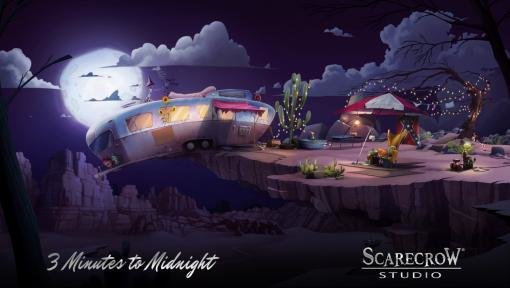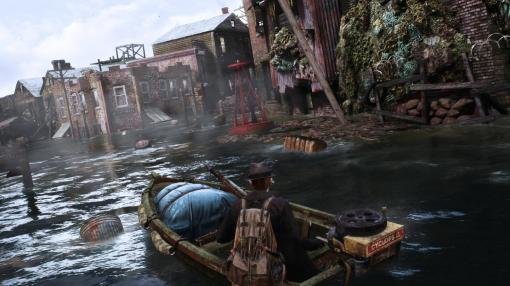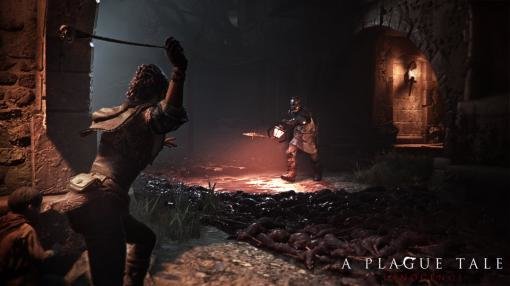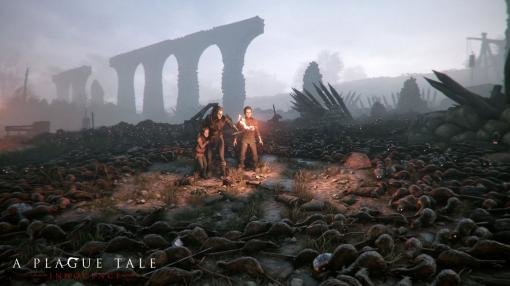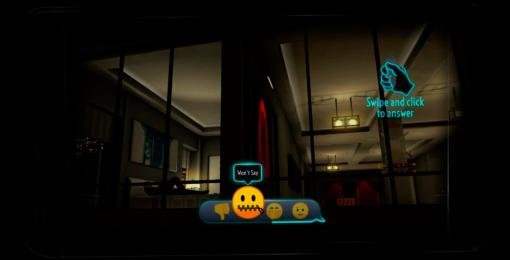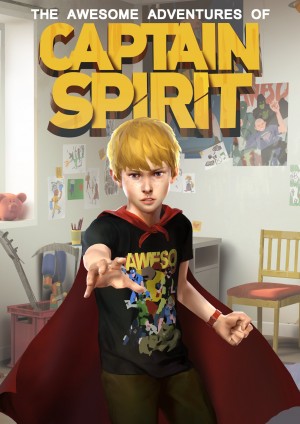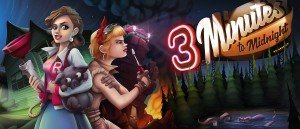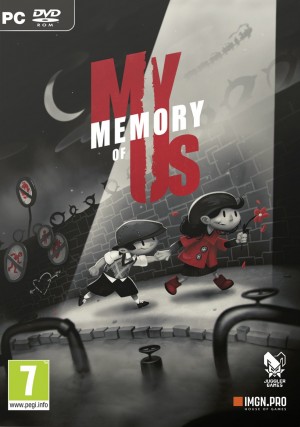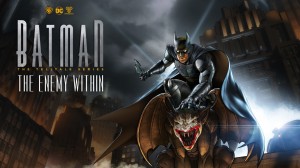E3 2018 round-up page 3
Events Coverage
Reporting from E3, GDC, AdventureX, Gamescom and other gaming events around the world

It’s a great time to be an adventure gamer, and from what E3 was showing this year, that doesn’t look to change in the foreseeable future – at least if you're willing to venture beyond traditional point-and-click, and particularly for those who can handle a little action with their story-driven puzzles. Over the course of several days I scoured the City of Angels, from high rooftops to personal meeting rooms off the E3 show floor to get the latest info on games both newly-released and still upcoming in the next few months and beyond. The games themselves will take us even further, from a dystopian future Berlin all the way back to 14th century France, allowing us to experience stories that take place on distant planets or on the fire escape right outside the window. Promising a little something for everyone, enjoy this look back at the adventures of E3 2018.
The Awesome Adventures of Captain Spirit
If you played and enjoyed DONTNOD Entertainment’s Life Is Strange, well then you probably don’t need me to sell you on The Awesome Adventures of Captain Spirit; the game will be free to download as of June 26, 2018, so go ahead and play it already!
Not that this is another installment in the lives of Max Caulfield and Chloe Price, however, nor is it set in Arcadia Bay. Instead, this two-hour episode serves as a sort of “playable demo” (DONTNOD’s words) for the upcoming Life Is Strange 2. The connections aren’t fully clear yet, but the developers do promise that Captain Spirit features a character that will also make an appearance in the next series, and that there will be several easter eggs within the game that connect them all to the same shared universe.
The decision to make the game free of charge is twofold: 1) It can be considered a thank you to the franchise’s fans, and 2) the developers hope to stir up some additional interest in Life Is Strange 2 before it has even officially been unveiled.
On the surface, Captain Spirit plays identically to the French studio’s previous efforts: explore the environment, press buttons indicated on-screen to interact or examine objects all around you, then sit back and watch the slow-burn narrative unfold. This time around, players will take on the role of Chris, a nine-year-old boy with a very active imagination. Players will help Chris create a superhero persona to deal with a recent traumatic event in his life. Of course, a superhero needs a nemesis to fight and a day to save, and so Chris creates a to-do list of his heroic objectives for the day.
When Chris dons the identity of Captain Spirit, the world around him changes. A garage becomes a fantastical evil villain’s lair, a snowman a nefarious rival with the power to freeze his opponents. Even some normal objects in and around Chris’s home (where the game takes place) have secondary interactions when activated with Captain Spirit’s “superhero interactions.” For example, Chris is afraid of going into the dark garage, but once he dons Captain Spirit’s costume, being afraid of the dark is no longer a problem.
Charming little touches like these permeate the game, and fans of character building can look forward to plenty of little touches that truly make you begin to care about this world and the people in it. The developers have even hinted that some of the choices made in Captain Spirit may carry over into Life Is Strange 2.
The Awesome Adventures of Captain Spirit is a free download for Windows PC on Steam, as well as PlayStation 4 and Xbox One starting June 26, 2018.
Call of Cthulhu
When private investigator Edward Pierce is called to Darkwater Island to investigate the mysterious death of Sarah Hawkins, he has no idea exactly what he’s about to get caught up in, for Cthulhu stirs and a secret cult in 1920s Boston is setting the scene for his arrival. Cyanide Studios’ atmospheric first-person RPG detective game is steeped in Lovecraftian lore and challenges players to retain at least a shred of their sanity as they investigate the visions of madness that haunt the island.
In a darkened showroom off the bustling E3 floor, I was invited to watch a gameplay demonstration. In our demo, Edward, along with a member of the local constabulary, was conducting a nighttime investigation of Hawkins manor, in particular to find out why a suspicious fire had recently erupted there.
As Edward investigates, a white border appears around the edge of the screen to let you know you can enter detective mode. This taps into Edward’s considerable deductive powers, slowly piecing together what happened at a crime scene, using whatever clues you can find. While attempting to pin down the cause of the fire, a question mark icon alerted us that there were still undiscovered objects or clues nearby.
Call of Cthulhu incorporates quite a lot of player choice into its gameplay systems. You create a character by assigning points to certain skills at the start of the game, which Edward can then raise throughout by finding related books. Talents like psychology, forensics, lockpicking, and occultism can help you interpret clues, enter locations, and deal with suspects you encounter. The development team has made sure that every hurdle can be overcome in a number of ways. For example, late in the demo, Edward encounters a bookcase hiding a secret door that can be opened by solving a nearby globe puzzle. If, however, you aren’t able to solve the puzzle but have the prerequisite skill and item, you can simply use a crowbar to force the mechanism, opening the door.
The demo took us through several of the mansion’s rooms, revealing more and more about the Hawkins family through Edward’s detective vision. Of special concern are the frequent images of the young Hawkins boy, clearly terrified of something sinister. It seems the oil paintings throughout the manor are related to a ritual carried out by a dangerous cult that has some sort of connection to the Hawkins family. Suddenly, a noise lures Edward to the end of the hall. Slowly entering the darkened room, he finds – prominently displayed as if waiting for him – a previously undiscovered painting, this one depicting in clarity his own haunted face. Before Edward can so much as register the frightening implications of this, a robed figure bursts out of the shadows in the back of the room, and rushes right at him.
We weren’t quite at the end of the demo, but this example perfectly encapsulates what the game has to offer: a dark, foreboding case to solve, filled with plenty of Lovecraftian imagery and atmosphere, and all of it open to player choice to proceed in any number of ways. As Edward draws ever closer to the mythos of Cthulhu, his sanity will become increasingly jeopardized, though the developers stated that this is something that will affect the story only, rather than make gameplay more challenging. There will be some light combat against Edward’s human opponents, but when facing otherworldly Lovecraftian antagonists, fruitless fighting instead makes way for naked survival.
There is still some time to go before we can join Edward in taking on the Great Old Ones, but the game is on schedule to release sometime this year. Call of Cthulhu will be playable on PC, PlayStation 4 and Xbox One.
3 Minutes to Midnight
It’s a little curious, with all the games I saw at E3, that Scarecrow Studio’s 3 Minutes to Midnight is the only classic point-and-click adventure of the bunch. The developers’ love for the golden days of the genre is quite evident in many of their design decisions. From the tongue-in-cheek humor to the pop-art visual style, this game looks like a holdover from the glory days of LucasArts.
The setting of 3 Minutes is an interesting one. It’s the 1940s, post-WWII, in New Mexico – you know, the place rumored to be full of secret military bases, crashed alien spaceships, and more conspiracies than you can shake a stick at. Well, get ready to throw in one more, because Betty Anderson has just awoken to find that every resident of her town, herself included, is suffering from a perplexing case of simultaneous amnesia. Add to that the fact that, just prior, a nearby dam blew up and now the area is suffering a total power loss, and you’ve got all the makings of a classic Cold War mystery.
Taking place entirely in one night, in the few hours leading up to midnight, the game features a cast of 36 characters, all of whom come with a backstory that can be uncovered through fastidious gameplay. Though Betty is the story’s main protagonist, players will also take on the role of another character during a handful of flashback scenes.
The demo I played took place just after Betty returned from the demolished dam, having found it locked up tight. Her search for the keys to the dam leads her to a nearby campsite, situated on a scenic lake. The whole scene takes place across two connected screens, with several points of interest in each. The game uses a simplified control scheme: left-clicking interacts with objects, moves Betty, and initiates dialog, while right-clicking is used to examine hotspots.
The solution to finding the keys is evident as soon as Betty steps foot onto the campsite. In plain view right in front of her is a girl named Pamela, who turns out to have the item in question. But in order to get them, Betty must first navigate through a dialog puzzle with Pamela, who has a split personality to boot. Then Betty must accomplish several tasks at the campsite to prove herself worthy of becoming a camp counselor and, therefore, be granted access to the keys.
The process of accomplishing Betty’s various tasks was enjoyable, and there were enough objects to find and places to try using them to encourage some creative thinking trial-and-error. The logic difficulty was pretty well dialed in to the sweet spot, though my limited window of time necessitated one or two pointers in the right direction. For such a somber-sounding narrative setup, the humor is quite light-hearted, though some of it did fall a little flat for me, particularly the Pamela character whose affliction was portrayed a little on the wacky side.
Overall, I really enjoyed my time with 3 Minutes to Midnight. I’m particularly intrigued by the story setup and the general atmosphere of a 1940s black site mystery. The final game will feature a total of 54 scenes, some of which will change depending on the time of day, and support 15 different subtitled languages while being fully voiced in English. The team has their sights set on April 2019 and is considering releases on virtually all platforms, including PCs, consoles and mobile systems. A Kickstarter campaign to fully flesh the game out is planned to take place this September.
The Sinking City
Frogwares comes with some serious pedigree in the adventure gaming scene – after all, this is the studio behind the Sherlock Holmes series. Thematically, there is probably at least a little overlap between Victorian London and early 20th century New England, and when one adds the otherworldly sense of Lovecraftian-inspired mythos into the mix, it’s not much of a leap to believe that The Sinking City is in good hands.
Just what exactly those hands have been busy with is something I was able to take a look at myself when I sat down with Frogwares’ Community Manager Sergey Oganesyan as he walked me through a demo of the upcoming open-world action-investigation game.
Players take on the role of Charles Reed, a private investigator who can’t understand why he’s lost his memory, and even more why strange cases of insanity have been reported all across the continent. His investigation of these phenomena, and the otherworldly visions he’s been experiencing, brings him to Oakmont, Massachusetts, a fishing town flooded for months but whose residents still, strangely, refuse to leave. Little does Charles know that he’s in for one hell of a ride.
The Sinking City isn’t designed to be one straight shot through from beginning to end. Charles is on the trail of solving his own main mystery, true, but along the way he will come across several diversionary side cases you may wish to solve, which all help to paint a disturbing overall picture of what’s happening in Oakmont.
The demo began as a desperate wife sought Charles out in his hotel room, begging him to search for her missing husband. Her only lead: the address to a run-down fishing hut he uses. This is the first of several occasions when you are given a choice of how to respond and treat the people you interact with; these choices can have an impact on the outcome of your investigations (more than one ending to the overall game is also possible). Side missions must be organically discovered during the course of the investigation, encouraging players to be thorough and explore.
The game also doesn’t guide you along a set of waypoints to the solution of each case. Instead, to find the location of the fisherman’s hut, you must consult your map of Oakmont – split into seven districts complete with street names – and locate the correct intersection. Oakmont can be traversed in three ways: on foot in dry areas, by boat, or diving through the city’s many flooded streets and canals. Fast travel is available, but only to certain locations and only after they’ve already been discovered.
Arriving at the fisherman’s cabin to find it locked, Charles must climb his way inside, where several more gameplay systems are revealed. Evidence such as newspaper articles that further the investigation and the game’s lore can be found scattered around the environments. Charles can also pick up camera film, allowing him to take photographs that serve as evidence dialog topics during encounters with other townsfolk. For example, the gigantic drawing of an eye scrawled in blood on a wall in the cabin.
Ammo, too, can be found, and before he leaves the premises again, Charles will need to defend his life against some Lovecraftian monstrosities. This is where The Sinking City most sharply departs from its Sherlock predecessors. Drawing your gun as twisted masses of flesh shambles and shuffles toward you, you’ll engage in some light gunplay – a few rounds fired off to down each nightmarish opponent, nothing more fancy than that. However, coming face to face with hellish abominations and other stressful sights will take a toll on Charles’ sanity, which plays out by visually obscuring the on-screen image and making Charles see flashes of eternal space. One such sight is the headless corpse that you found bled out shortly before.
From here, the demo exhibited an interesting twist: there are multiple avenues to follow up on, either heading to the library to research the bloody symbol you discovered or to the newspaper office to follow up on one of the recovered article scraps. Which steps players take next will affect the outcome of this investigation – for me, it was the bad one. Thinking myself incredibly clever and insightful, my choices instead landed me right in the middle of a trap. If I’d chosen differently, so I’m told, I would have been able to sniff the ambush out ahead of time. But the cases are designed to end in a variety of ways, including not at all – perhaps if a key person or item is no longer available, the case simply remains an open mystery. Resolving cases satisfactorily can net Charles bonuses that will help him in solving the overarching mystery.
Apart from the mild action-oriented gunplay, there are also some segments focused on stealth as well as some light crafting. But despite this and the tense, horror-like atmosphere, Sergey stressed that The Sinking City, at its core, is an open-world investigation. The team still has a long road ahead spent polishing and fine-tuning the game, but what’s on display so far, particularly the dark atmosphere drenched in Lovecraftian imagery, is intriguing enough to keep a close eye on this one. The full 30-50 hour game is planned to release on March 21, 2019 for PC, PlayStation 4 and Xbox One.
State of Mind
Having already seen State of Mind at last year's E3, I checked in with the folks from Daedalic again this time to get the latest info on their upcoming 3D adventure. Speaking with the project’s Creative Lead Martin Ganteföhr, there were new things I learned, old things we knew, and a release date that’s right around the corner.
The game is first and foremost an investigative mystery centered around the moral implications of transhumanism, the theory of evolving the human race via technological means. Protagonist Richard puts his vocation as a journalist to good use by researching and looking for clues to solve the mysterious and sudden disappearances of his wife and son. In addition to puzzles, the game will also feature some light action cinematics and at least one stealth section.
Technology plays a large part in both the story and setting. On one hand, the citizens of dystopian Berlin circa 2048 rely on engineered implants in their everyday lives. For example, Richard has an implant that lets him make holographic calls to other characters at any point, facilitating the game’s communication portions.
Then there’s the seemingly utopian VR world that plays a large part in the mystery and houses artificial intelligences derived via mind uploads of Berlin’s living citizenry. Adam is one such clone, living an artificial life in an artificial city, ignorant of the fact that he is a copy and his whole life a lie. During the course of the game, Richard and Adam do interact, introducing one of its major dilemmas: at what point can an AI be considered “alive”? There are even distinct endings based on how the player chooses to resolve a final moral choice.
Since last year, the team at Daedalic has used the time to listen to player feedback, and there have been a series of tweaks made to the dialog and pacing, and several scenes reworked entirely to improve the overall experience. The game is also voiced, in both English and German, with Doug Cockle (Geralt of The Witcher) taking on the English role of Richard. A release date isn’t very far off, with August 16, 2018 the current target for PC, PS4, Xbox One and Switch.
My Memory of Us
As soon as I saw My Memory of Us, even from about fifteen feet away, I knew I was in for something interesting. After talking with a member of the development team, I heard nothing to think that my first impression steered me wrong in the least. I then got to spend several minutes playing, by way of a tutorial of sorts, which confirmed my initial reaction further.
The first thing probably everybody will notice about My Memory of Us is its almost-monochrome color palette. The majority of the game features beautiful black-and-white graphics, helping to set it in a historical place in time, namely Poland during World War II. The only pop of color is a bright red used for certain key features in a scene, like an article of clothing or the optical lens on the evil soldiers’ headgear.
You see, although it’s set during actual historical events, the game views these events through the imagination of the two children providing the story’s focal point. These two kids, a little boy and girl, meet one day just before the war breaks out, and quickly form a beautiful friendship.
But it isn’t long before the German army arrives – or, as the kids see it, evil robot soldiers invade their hometown. From here on out, the boy and girl must rely on their bond to get them through the real-life horrors waiting for them, all filtered through the lens of childlike imagination. I stopped playing the demo there – after all, this isn’t the kind of game I want to spoil for myself, either. Thankfully, we won’t have to wait long, as Juggler Games is bringing My Memory of Us to PC, PlayStation 4, and Xbox One as soon as September of this year.
A Plague Tale: Innocence
Some games showcase the fun and friendly side of E3, with colorful worlds, lighthearted humor, and feel-good stories – and then there’s Asobo Studio’s A Plague Tale: Innocence. Other games may be more graphic or adult-themed, but this one is about as thematically dark as dark gets.
The game asks players to guide siblings Amicia and Hugo safely across 14th century southwestern France. The catch? Oh, if only there were just the one. Soldiers of the Inquisition are doggedly chasing the pair, Hugo is infected with a deadly disease, and hundreds upon thousands of rats carrying the Black Death flood the countryside, on the hunt for flesh to consume. But the siblings have one trick up their sleeve: the rats are deathly afraid of light. This knowledge is more than just a way to keep safe; when applied cleverly, it can be a deadly weapon against the hordes of foes hunting down the kids.
Sitting in a private meeting room, the demonstration for A Plague Tale began with Amicia and Hugo being ferried across a river by Lucas, another child on the run from the law like themselves. For the duration of the demo, Lucas and Hugo followed automatically while Amicia was the player-controlled character. Disembarking the boat, the three come upon a recent killing field, semi-fresh corpses of combatants literally piled up as far as the eye can see in the pre-dawn mist. Reluctantly, the trio begins making their way across, Hugo understandably dismayed and fearful at the prospect of having to walk on dead bodies.
If that wasn’t bad enough, the group halts as a horse lying on its side a few feet in front of them suddenly begins thrashing, apparently not yet dead. But it quickly becomes clear that appearances can be deceiving – the horse is indeed quite dead, and what appears to be the thrashing of limbs and body is actually something, or rather many somethings, inside the horse trying desperately to get out. As the poor animal’s hide tears apart, a river of glistening, slithery rats pours forth, and from everywhere all around, heading for the children to devour them.
This scene in itself was so shocking that it immediately seared itself into my memory. Appalled, I still couldn’t help but keep watching. Luckily, Amicia knew just how to handle the situation. Seeking refuge by the dim light of a lantern, the three were relatively safe for the moment. A few feet away, another lantern spelled out A Plague Tale’s main gameplay mechanic: seek safety in the light. But still there was worse to come.
Before long, lights begin bobbing in the distance: lantern-bearing soldiers heading toward the children, searching for them. Out of options and with nowhere left to run, Amicia knows there is only one way to save herself and the others. Taking out her slingshot and taking aim for the nearest soldier’s lantern, she deftly shatters his source of light, instantly marking him for a grim and violent death at the teeth and claws of the rats all around. As the soldier, now a shrieking mountain of rats, screams his last, the kids sneak past the otherwise-distracted rodents and on to the next leg of the demo.
Things continued in this vein for a few more minutes yet. Using the same mechanics, the player will need to continuously create a path for the kids to make their way through the treacherous terrain. One particularly notable sequence saw the children making their way with a lit torch, driving a sea of rats ahead of them. On the far side, a soldier standing before a metal grating, with no other exit in sight. Unfortunately for him, fleeing from the fire meant the rats only had one way to go, and he was squarely in their way. As the soldier began screaming in terror at the advancing rats, driven by Amicia and her torch, she started sobbing, apologizing from the bottom of her heart to the man she has doomed to a torturous death, forced to do so to ensure her own survival.
As mature and grisly as these images were to digest, they are also an enticing hook that offers some truly enthralling moments. Although promising a memorable narrative, this isn’t really an adventure game as such, nor is it focused on action gameplay. As the designer showing off the demo put it, it’s about “being smart to survive.” A Plague Tale: Innocence releases in 2019 for PC, PlayStation 4 and Xbox One.
Planet Alpha
Many adventure games can end up being quite dialog-heavy in telling their stories, but Planet Alpha is one of those few games that attempts to tell a compelling tale without ever uttering a single word. Admittedly, the game is more of a puzzle-platformer, with the occasional bit of stealth thrown in. But that doesn’t keep it from weaving an intriguing narrative, even based on the first chapter I was able to play through.
Players take on the role of a being (possibly human, possibly otherwise) who has just awoken on a foreign planet. While it’s unclear who you are or how and why you’ve arrived here, the fact that you spend your first few moments of gameplay alone, limping away into barren nothingness suggests that this isn’t how things were planned. After several scenes of dragging yourself progressively slower through various landscapes while opening credits appear and vanish, you fall to the ground, exhausted, and the screen fades to black.
A few seconds later, a seemingly healed and revitalized you are ready to tackle the game in earnest, allowing you to run and jump to your heart’s content. Wondering how this happened won’t help, as the game does not provide any answers at this point. Perhaps it has something to do with that mysterious humanoid figure you may have glimpsed hidden way in the background earlier, if you were paying attention?
This use of environments and character animations is how Planet Alpha initially tells its story. The remainder of chapter one is a relaxing, wondrous experience of simple platforming through a beautiful alien landscape, accompanied by ephemeral music. For a few minutes, I was fooled into thinking this was one of those games meant to inspire you to breathe deep, find zen, and exhale.
But don’t turn your brain off, as a simple puzzle incorporated towards the end of the first chapter asks you to figure out how to operate a room-sized alien device, still without words. Then, when the 1940s-era sci-fi robots arrive to mark the commencement of chapter two, stealthily hiding away from what looks like foes is introduced to the mix.
How Planet Alpha continues is anybody’s guess, though I’ll bet enigmatic vistas and peaceful exploration interrupted by further moments of tension will be par for the course here. The game is planned to take a handful of hours to complete, and will be available pm PC, PS4, Xbox One and Nintendo Switch sometime later this year.
Moss
Although their premier VR action-adventure Moss just released earlier this year, developer Polyarc was already back at E3, though not yet ready to talk about the future of their tiny protagonist Quill. Instead, they shared some up-to-date news on the game’s continued evolution, including some quality-of-life improvement even those who’ve already played it may appreciate.
For starters, the once-exclusive PlayStation VR title has since branched out to PC, where it is now playable on the Oculus and Vive. This does mean some slight changes to the gameplay: having two VR controllers instead of one DualShock 4 means two in-game spirit hands. This translates to the ability to simultaneously hold onto an enemy with one while healing Quill with the other, whereas only one or the other was possible before. Of course, the PC release also features some graphical updates.
But there’s news for PSVR owners, too. A physical copy of Moss is now available on the console, having literally launched the same day I saw it. All versions will receive several retroactive updates, including the ability to start several games in dedicated save slots and support for multiple languages. Finally, completionists looking to collect every scroll and piece of magic dust will now have a helpful indicator to let them know which chapters still have hidden goodies, even for those who already finished the game previously.
Polyarc was very tight-lipped about any potential for future releases, indicating that more Moss is a possibility but that a new IP isn’t out of the question, either. More immediately, however, fans can look forward to an upcoming Moss soundtrack release.
Anderson
Three-man studio AJRPG hopes that more than anything their debut project will serve as a showcase of what they’re capable of creating, serving as a gateway to raise interest in their next, more commercial project. Anderson is a VR escape-the-room game with some story elements infused that is meant to be completed in a single sitting – well, standing – only lasting 20-45 minutes, depending on your skill at solving its puzzles. Created from free Unity assets, the team’s mantra is, “If we didn’t pay to make it, the player shouldn’t have to pay to play it.”
Waking up in a small metal-encased room, approximately the size of a broom closet, you have to solve a series of item-based and logic puzzles to attain your freedom, and maybe find out who you are and why you’ve been locked up. Your only companion is the eponymous wall-mounted, completely voiced AI unit, who provides some commentary on your objectives along the way.
The controls worked reasonably well, with two handheld controllers used to move in-game VR hands around the environment, grasping and moving objects to manipulate them. The graphics are about what one might expect, given the situation, but setting the game in a bland, enclosed space definitely serves to downplay the visual importance. Any story elements come in the form of hand-written notes found in the room, so in that sense the narrative is really completely optional.
Anderson is already available now on Steam, free of charge, for HTC Vive and Oculus Rift.
Fire Escape
New York-based developer iNK STORIES has come up with a modern take on a classic Hitchcockian theme with Fire Escape, a short, three-part VR mystery that’s all about the voyeuristic thrill of being an observer.
Taking its cue from Rear Window, the game casts players as an average person standing on their fire escape late one evening, drinking in the sights and sounds of a small apartment community in a big city. Looking out over a courtyard flanked by more rear-facing windows on three sides, all of your neighbor’s lives are on display for you, the unseen observer standing in the shadows.
Gameplay elements in Fire Escape are very light; the only two actions available are to look around the VR environment and use the cell phone in your right hand. The cell phone allows for communication by letting you receive incoming calls, wordlessly responding to the other party by choosing emojis to send back. It also lets you zoom in on a specific neighbor’s window, which, in turn, also lets you isolate the sound coming from their apartment over the general din to let you hear and see what’s going on.
While at first this all seems a little aimless, albeit intriguing, a crime will happen by the end of the first episode. I was told that, since the player is short on actions, the game isn’t so much about what you do about the crime, but rather observing the reactions of those around you.
At only about an hour in total length, with each of the individual episodes clocking in around twenty minutes, Fire Escape won’t take up more than an afternoon of your time. But with about half a dozen individual stories unfolding within the tenants’ lives, all fully voiced, there is a little bit of replay value. Despite the inherently voyeuristic nature of this title, I was assured that it doesn’t stray into adult-themed territory.
Fire Escape is available on Google Play to use with Google Daydream, with the first chapter free and the rest unlocked through in-app purchase.




